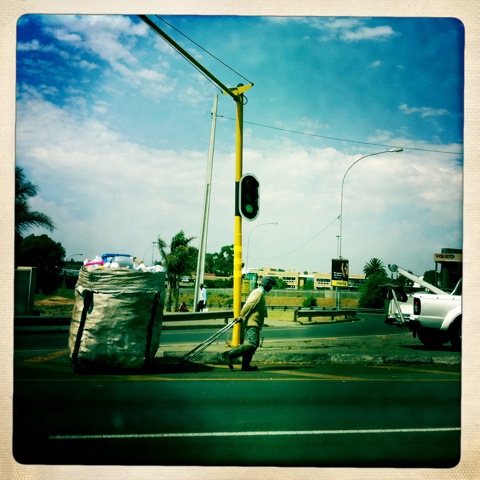New Hope School, a beacon of hope and education for children with special needs in Pretoria, is set to receive a generous donation of…
Instagram: the retro-social photography app

 My first camera was a little Kodak Instamatic, with a fixed-focus lens and a revolving cube of flashbulbs on top, that my father bought me on the eve of a school trip to the Kruger Park. Even way back then I was an irritating early adopter, the only kid on the bus pointing and shooting out the window as we wound our way past the wonders of the wild.
My first camera was a little Kodak Instamatic, with a fixed-focus lens and a revolving cube of flashbulbs on top, that my father bought me on the eve of a school trip to the Kruger Park. Even way back then I was an irritating early adopter, the only kid on the bus pointing and shooting out the window as we wound our way past the wonders of the wild.
My pictures were fuzzy and blasted with glare — an elephant skull at Shingwedzi, a giraffe, a distant herd of impala — but in retrospect, they captured the light with a freshness and charm that seem to have vanished from photography forever. Until now.
I have had many cameras over the years, from a Pentax Spotmatic to a Minox spy-cam to a Nikon D200 to a hefty Leica M4 with a shutter as whisper-quiet as the silencer on James Bond’s Glock.
But my latest camera isn’t really a camera at all. It’s an iPhone app called Instagram, and it has magically transformed my high-tech smartphone into a low-tech toy. But what a toy. I snap pictures with my iPhone, with its fixed-focus lens, its rigid auto-exposure, and its slow, lazy shutter, and then I visit Instagram and experiment with the special effects filters, which have names like Lomo-fi and Poprocket, Nashville and 1977.
Something happens… an act of alchemy that breathes new life into flat, dull photographs, coating them with a patina of memory and meaning, their colours as rich and saturated as a 1940s movie musical, or fading into sepia like a half-remembered dream.
Mere facsimiles of reality, shot with a phone, somehow become works of art, fit to be hung on a gallery wall, or used as album covers by indie bands with Post-Modern pretensions.
The real joy of Instagram, which has swept across the Net at light-speed since its launch a couple of weeks ago, is that it makes photography social again.
Of course, photography has always been a social medium, after all, what other art form can boast “Smile!” as its catchphrase, but Instagram redefines the territory by encouraging happy snappers to find and follow others of their ilk, just like on Twitter, and “Like” and comment on their updates, just like on Facebook.
Instagram seamlessly integrates with these and other social platforms, creating a global community abuzz with the rediscovery of photography’s elemental magic. Flicking through the photographs in your feed, the montage of frozen moments glimpsed through other people’s eyes is like chancing upon a shoebox of weathered prints in an attic, or sitting in a circle sharing snapshots with your friends. But Instagram also taps into another curious phenomenon of our push-button, touchscreen age. The quest for imperfection.
The rise of digital technology has democratised technical competence, allowing almost anyone to produce a decent pic, a slickly-edited video, a cool-looking website. But what the technology boasts in clinical quality and ease of use, it tends to lack in emotional warmth and resonance.
Hence the allure of technostalgia, which beckons us back to the quirks and flaws of yesteryear’s analogue formats. And so we have the horror movie shot on cheap, grainy videotape, the pop album recorded in low-fi on a four-track cassette deck in a bedroom, the artificial overlay of scratches and grit on a square-format image snapped with an iPhone. This is not just the province of the enthusiastic amateur.
Nadine Hutton is a Johannesburg photographer whose arsenal of professional equipment includes a couple of 20-megapixel Canon DSLRs and a Mamiya 6X6 Medium Format film camera. But she, too, has fallen in love with the iPhone, using it as a visual note-taking tool, a location-finder for assignments, and an always-to-hand “mik en druk”, capable of capturing great images in its own right.
Nadine’s app of choice is Hipstamatic, which mimics the tint and grain of a low-res, limited-edition plastic film camera of the 80s. She has been using it to shoot a series of exhibition-worthy images of Johannesburg and surrounds, called #JoburgDriveByShootings.
“The iPhone with Hipstamatic is perfect to shoot Joburg,” says Nadine. “The messy textures suit the grubbiness of the city, and I feel like I’m taking pictures I found in my photo albums growing up.”
The iPhone imposes strict limitations on the photographer, but the invitation to transcend those limitations is what creates a special kind of art. “The first limitation is resolution,” says Nadine, “and the only way you can zoom is to move your body. But I like the fact that the iPhone has taken my photography back to the basics of a prime lens. I’ve found myself photographing things I ordinarily wouldn’t as a photojournalist. I’m looking at the world differently, looking both deeper and more superficially, if that makes any sense. It’s making me a better photographer and I’m having fun doing it.”
Of course, that’s the key. Technology used to be fun and exciting, until digital came along and made it all too easy and perfect. But now, digital itself has found the solution: just go retro.
Personally, to be honest, I don’t really miss the little Kodak Instamatic that inspired my love of photography. It was a sweet device, but in retrospect, in an emergency, it would have been completely useless as a phone.


